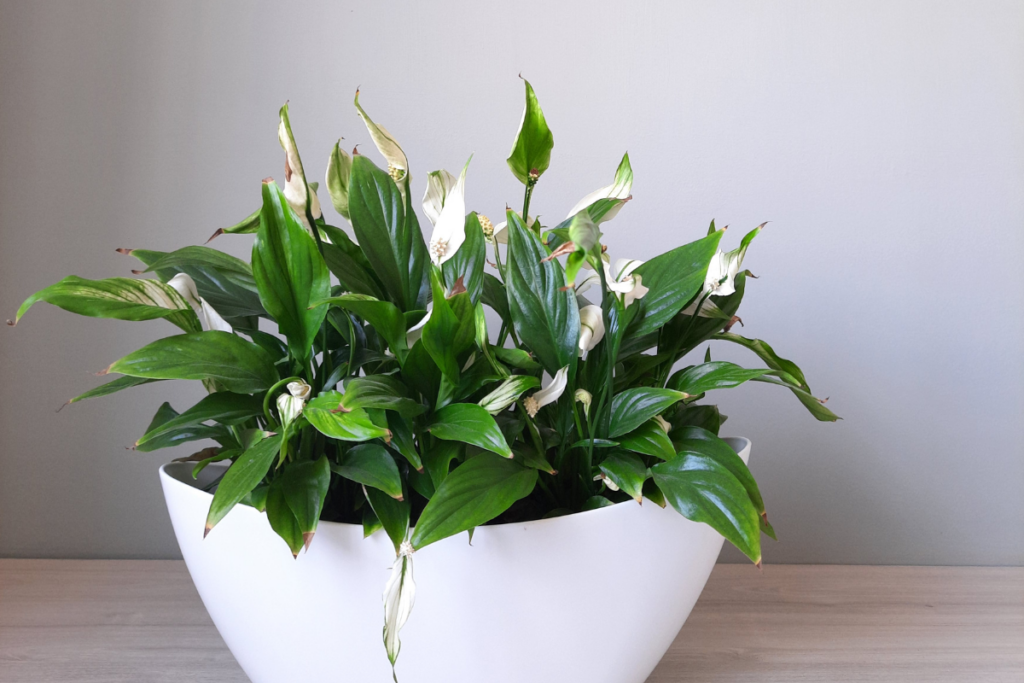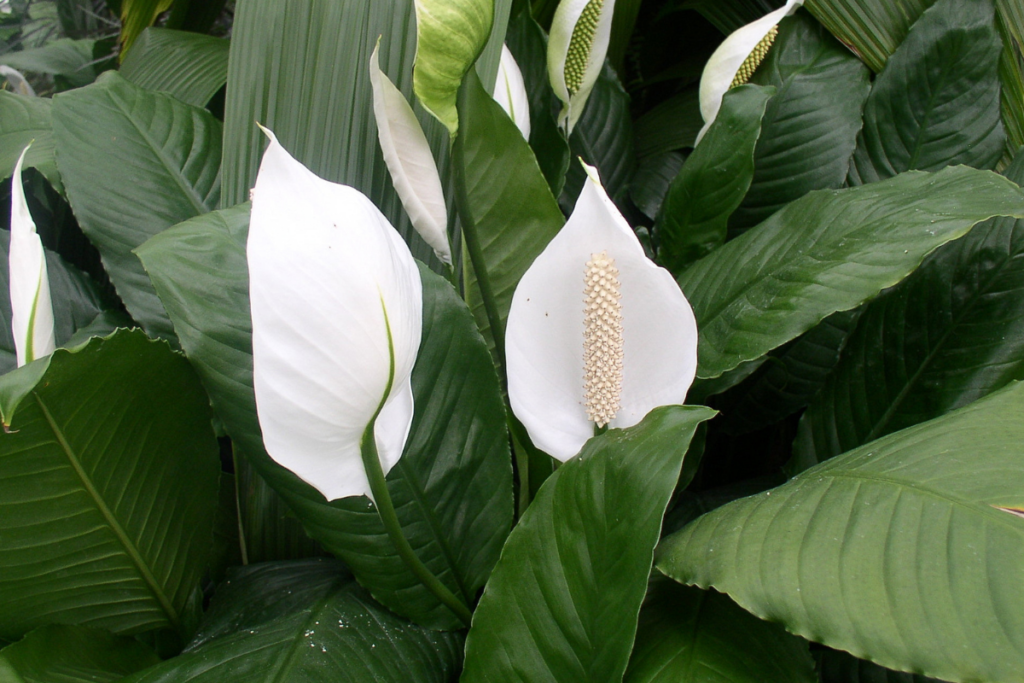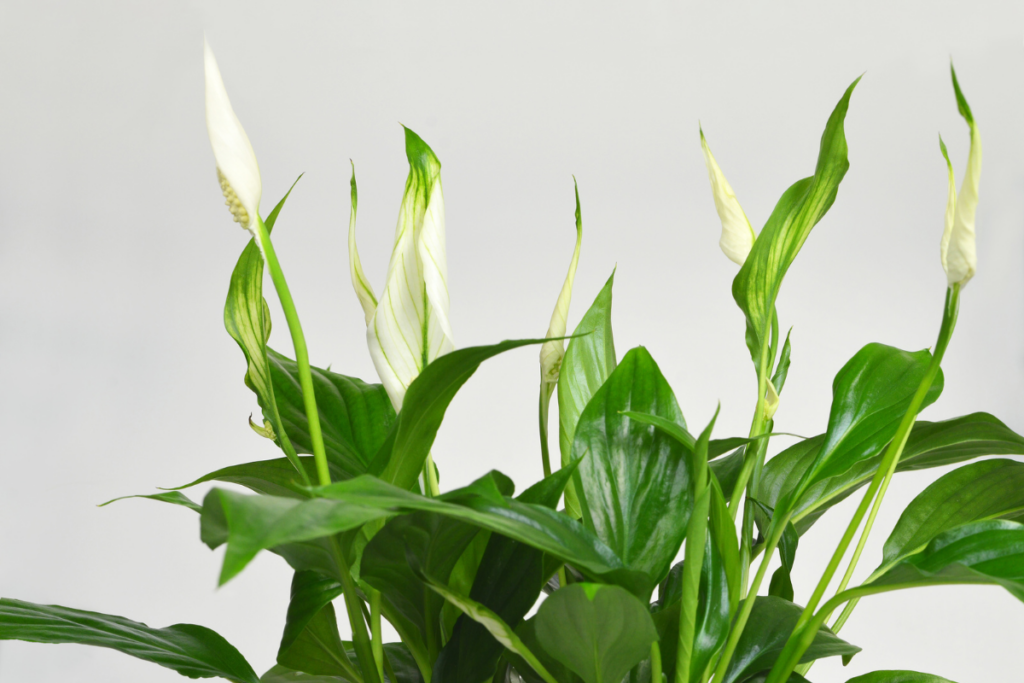Typically, you want your Peace Lily to become as huge and lush as it can. However, sometimes it is best to scale your plant down for health and growth reasons. In this article, let’s talk about how when where and why to trim or prune your peace lily.

While pruning Peace Lilies is not necessary on a regular basis, doing so will benefit the health of your plant. Remove the whole stem underneath a peace lily bloom as it begins to wither. Do the same with leaves that have aged or suffered injury and have turn yellow or brown. Cut at a 45-degree angle close to the soil.
In addition to keeping your peace lily healthy, you might want to prune your Peace Lily for aesthetic reasons or because it has outgrown its current container. Debris removal from a plant may also be a relaxing activity that provides a chance to inspect it for pests, damage, or illness.
Everything you need to know about when to prune your Peace Lily and why it’s a good idea is covered in this article. We’ll also provide you with some advice on how to do the task in a manner that encourages your plant to recover fully.
Let’s examine the delicate technique of trimming Peace Lilies in more detail.
RELATED: How To Revive A Dying Peace Lily: Essential Tips and Tricks
Why Is It Important To Prune Peace Lily?

You may question whether your Peace Lily need an annual trim if you’re accustomed to caring for blooming shrubs and trees. Spathiphyllum plants can grow and blossom quite well without any routine trimming, thus the answer is no.
That does not imply, however, that there is never a need to use the shears. Even though they are not technically essential, some judicious pruning might be beneficial for your Peace Lily.
A few justifications for maybe cutting back a Peace Lily are as follows:
- To Promote Growth
The older, outer leaves and stems on your plant will ultimately shrivel up and die while new ones grow. The plant will continue to use part of its energy sustaining them while they are waiting to be dropped off. Once the leaves begin to wither, you may remove them so that your Peace Lily can focus its energy on creating new growth. This will result in a fuller, more robust plant.
- To Encourage Flowering
The same way that eliminating old stems encourages the Peace Lily to grow new ones, getting rid of old flowers may encourage it to bloom once again. Although this isn’t a perfect strategy, in general you’ll receive more blooms if you take the initiative to remove the wasted ones.
Keep reading on how to encourage flowering to your Peace Lilies.
- To Eliminate Clutter
Older leaves will eventually fall into the pot and begin to rot if you don’t remove them. Fungus gnats might be attracted to the soil by an excess of decomposing organic waste. Although they often don’t hurt your Peace Lily, they are undoubtedly inconvenient and ugly.
- To Keep It Under Control
Not everyone wants huge, spreading indoor plants. Sometimes it’s preferable to keep your Peace Lily to a manageable tabletop size. Pruning the stems—and sometimes the roots—can aid in that.
- To Make It Beautiful
It only makes sense to maintain your plants as beautiful as possible as they are a component of your design. Inconsistent stems, wilted petals, and yellowing leaves are probably not what you had in mind for your Peace Lily. Take immediate action to get rid of them.
RELATED: How To Repot A Peace Lily: Helpful Tips To Avoid Transplant Problems
When Should Peace Lilies Be Pruned?
Pruning is not necessary for peace lilies to remain robust and healthy.
In contrast to other blooming plants, peace lilies do not often produce flowers. Therefore, unlike other blooming plants, you do not need to cut the cluster of buds at the conclusion of the growth season.
When it comes to trimming peace lilies, there is no right or wrong time.
Before pruning the peace lilies, you must wait for the blossoms to droop and fade. And after the first flowers appear, this often takes a month.
If the blossoms and stems start to turn green, you may prune them. Nothing has to be done while the leaves are still green. Deadhead trimming should only be done in the late spring when just a few flowers have faded, never sooner.
You may prune brown and dead leaves at the same time as you prune dead blossoms.
As long as the plant is flourishing, you may trim a big or overgrown peace lily plant at any time of year. To maintain the peace lily’s health, you may trim the extra growth and take out the damaged areas.
Will A Cut Peace Lily Grow Back?

Understanding how your Peace Lily grows can help you plan your trimming. A Spathiphyllum’s stems are different from a tree’s twigs and branches. They resemble the delicate stalks that a leaf uses to attach to the branch where it grows.
A Peace Lily’s “stem” is underground. These plants develop from rhizomes, which are large, tuber-like root systems. This enables them to spread out under the ground, allowing a single plant to cover a large area and sprout branches in various locations. A Peace Lily may use this tactic to aid with both survival and reproduction, giving it a chance to flourish in one place even if it perishes in another.
A Peace Lily develops leaves and flowers on distinct stems, each of which connects to the rhizome. Trimming those stems won’t cause them to reappear. Instead, fresh leaves will emerge from the ground.
However, even if you unintentionally cut too much off with your clippers, your plant may recover from only the roots and rhizomes. Your Peace Lily should withstand the loss of any quantity of leaves as long as the subterranean component of the plant survives and the growth environment is favorable. Just be aware that it won’t recover too soon since these plants grow slowly.
How To Properly Prune A Peace Lily?

Now let’s talk about how to prune a peace lily. Pruning a peace lily involves these five steps.
- Examine the plant.
You must move back from the plant and assess the level of damage before starting the pruning procedure. Check to see if your plant has any damaged leaves, dead flowers, or drooping leaves. Look at the plant’s base, where the oldest leaves are located.
- Clean and disinfect the pruning tools.
Disinfecting the tools you want to use is required before beginning the pruning procedure for peace lilies. Pruners may be cleaned and sterilized using a soap and water solution. Pruners must be sterilized to prevent disease transmission to the plants.
- Eliminate the wilted and overgrown stems and leaves.
In this step, you must remove all the excess or broken stems and leaves from your peace lily which take up too much space. Yellow, shriveled, sick, and leaves with brown edges or blemished areas should all be pruned. These leaves give the plant a worn-out appearance. Make tiny incisions on the leaves and remove the damaged area to prune the leaves that have been damaged.
Make a cut at an angle under the brown leaf tips. The leaves won’t oxidize thanks to this angled cut. If the leaf is not injured in its whole, you do not need to clip it back completely.
Never cut them from the center; instead, make a crisp, clean angled cut that is only long enough to remove the damaged portion. Trim those broken leaves back and remove them from the stem base where the leaf stalk joins the stem.
When trimming the excess growth or repairing the damage, cut the stems at 45-degree angles.
- Deadhead your plant.
When trimming a blooming plant, deadheading is a common practice. To create place for the fresh blooms, we trim the dead ones during deadheading. Identification of the spent peace lily blooms is the first stage in the deadheading process.
Focus on removing the bud from spent blooms while deadheading a peace lily since these buds will eventually develop into seeds and prevent future blooming.
Prior to the first set of healthy leaves, this practice should be carried out. All of the brown flowers may be removed by pinching or shearing the stalk above the flower’s base. This process must be repeated on all of your plant’s spent flowers. Look within the plant’s leaves for any buds that could be concealed there.
Each stem of a peace lily will produce one bract, thus you must remove the wilted blossoms and the whole stalk since the stem will later turn brown. Trim stems as near to the plant’s base as possible.
When trimming a blooming plant, deadheading is a common practice. To create place for the fresh blooms, we trim the dead ones during deadheading. Identification of the spent peace lily blooms is the first stage in the deadheading process.
- Make time to tidy up after pruning
When you’ve finished pruning your peace lily, it’s time to clean. Get rid of any ill or broken leaves, blossoms, or other plant components that you have clipped.
Put them in a bag and dispose of them properly. Don’t forget a single piece. Cats and dogs may be poisoned by peace flowers. Therefore, if you leave behind any leaves, stems, or flowers, your dogs won’t be able to safely eat them. After pruning, clean your shears with an alcohol solution, soap solution, or water solution.
By doing this, illnesses that could be the cause of your plant’s yellow leaves will no longer spread.
To obtain new peace lily plants, you may propagate healthy stems by pruning them, however.
How To Best Care For Peace Lily After Pruning?
In order for your peace lily to recuperate and become healthy once again after pruning, you must take good care of your plant.
Some maintenance advice is available for your gorgeous peace lily plant.
- Water
Peace lilies need to be watered often since they enjoy wet, damp soil. Keep your plant properly watered, and don’t let it become too dry.
Read more about proper Peace Lily watering.
- Light
Because potted peace lilies are sensitive to direct sunlight and may become sunburned, keep them in an area that receives mild indirect sunlight.
Never set a peace lily in an area where the temperature is below 45°F since it is sensitive to the cold.
- Soil
Rich, loose potting soil with plenty of organic materials is preferred by peace lilies. Keep the soil moist, but don’t overwater peace lilies since they prefer dry circumstances to wet ones.
Little fertilizing is necessary for peace lilies. The application of a 20:20:20 fertilizer once every six weeks would be advantageous.
- Repotting
When your peace lily becomes rootbound, you should repot it. Repot it with a fresh soil mixture in a container that is one size bigger. Before repotting, remove all of the plant’s damaged and dead portions.
Can Peace Lily Roots Be Trimmed?
A Peace Lily may be kept from growing too large by pruning, but bear in mind that it is also developing underground. The plant’s root system will exceed the container if the foliage is continually pruned back while being kept in the same pot. As the tangled roots prevent their neighbors from getting adequate water and nutrients, this might cause health issues.
You may prevent potting up your Peace Lily by giving its roots a periodic cut, which will also inhibit the growth of the leaves.
Early spring is the ideal period for this sort of operation. Your plant will start to grow for the forthcoming season, which will aid in its stress recovery. It’s a good idea to carry out this procedure anytime you would typically repot the plant, which for most Peace Lilies is around every 2-3 years.
Can A Peace Lily be Grown from A Cutting?

Every pruning is a chance for new specimens since certain plants may reproduce from a section of their stalks that has been cut off. Sadly, Peace Lilies can’t make this work.
All of a Spathiphyllum’s growth nodes are hidden away within its root system since it generates rhizomes rather than aboveground stems. None of the cells that may develop into new roots or foliage are present in the stems or leaves. A Peace Lily can only be produced by pollination or by severing its root mass.
Final Thoughts
If your peace lily plant has outgrown its place or the blossom starts to droop and wilt, prune it. For your peace lily to blossom again, you must deadhead the flowers and prune the whole stem of the plant.
While trimming, remove the wilted, sick, and brown, yellow, and brown leaves.
Because peace lilies are poisonous to animals, always careful to clean up after trimming and never leave any plant pieces left. Give your peace lilies the right amount of light, heat, water, soil mixture, fertilizer, and trimming at the right time to promote their healthy development.
Hope you like our article on how when where and why to trim or prune your peace lily. Make sure to also check out our other plant care tips:
Spider Plant: 12 Stunning Varieties You Can Get For Your Home







